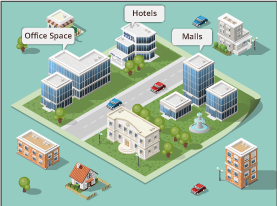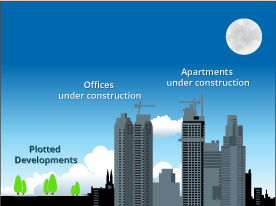Many would-be investors would like to take full advantage of real estate opportunities in India but find the prospect daunting and confusing. Different categories of property—residential, commercial, industrial, and agricultural—each have their own sets of laws and regulations and even subtypes. This article will attempt to shed some light on the most popular classes of real estate and the circumstances under which each type would be appropriate for an investor.
Broadly speaking, investors tend to have one primary aim in mind when venturing into real estate: either generating rental income or seeing an appreciation in the property’s resale value. Although income-producing properties do also appreciate over time, this gain is linked to the increase in the capital values as a result of increased rent. By contrast, investment in the development of a real estate project presents yields from the value added to the land by the developer.
Described below are types of investment categorized by their primary purpose: income or appreciation.
Income opportunities
Office buildings

Traditionally, offices in India have been of very poor quality, but over the past decade this has changed dramatically. Multinational corporations, many of which have established offices in India for IT outsourcing purposes, have created demand for facilities that meet or very nearly meet international standards. (As a result, Grade A office buildings have earned the confusing name “Tech Parks”, no matter what kind of companies the tenants are.) Today, India has a large and growing inventory of Class A commercial space, primarily in the major offshoring centers of Bangalore, Hyderabad, Pune, Chennai (Madras), Mumbai (Bombay), and Delhi (NCR or National Capital Region). As world-class offices become more prevalent, domestic companies are also choosing to locate in such prime environments. Over time, high-quality facilities are expected to become the norm for all companies above a certain size.
Office buildings are typically priced based on a capitalization rate, which is a multiple of their net operating income (rent minus operating expenses). There has been a massive flood of private equity money into the high-quality rental space, with most of the major international real estate funds having a significant presence in the country. The majority of commercial space developers have strong relationships with one or more such funds. Overall, the experience of foreign investors in India’s commercial property market has been a positive one with reasonable rent yields of around 8%.
Hotels
In the case of hotels in India, buildings are typically owned by a real estate investment firm while the property is managed by a hotel company. Thus, the asset value (land and building) and the operating value are split, with each entity receiving its appropriate share of profits. While the right hotel venture can be quite attractive, these investments require a sharp understanding of the dynamics of the hospitality industry, including the economic cycles that affect business. Unlike a rented office building with a lock-in period, a hotel does not have any protection from oversupply; existing hotels and new entrants alike suffer when supply outpaces demand. Nevertheless, a well-chosen hospitality property can be quite a sound investment and offer excellent long-term returns.
Malls
Initially, India’s retailing sector was somewhat slow to begin evolving from local mom-and-pop stores to national and global chains and brands. However, this evolution is now in full swing, and organized retail, as a whole, is booming. Although there are superb investment opportunities in this sector, investors must research the options meticulously. Many developers have built malls without regard to potential demand, and with a glut of malls in certain areas, some retail properties are underperforming. As with the hospitality sector, retail requires a clear understanding of the opportunity and a judicious evaluation of demand and future supply.
Other income-producing assets
Although commercial, hospitality, and retail assets are the most common for passive investors, quite a few other assets offer passive income. These include rental apartments, hostel-type accommodation for IT workers, industrial buildings, and logistics warehouses.
Infrastructure
India’s infrastructure—most obviously in terms of electricity generation and road construction—has lagged severely behind the country’s economic advances. Some of these sectors, while not strictly real estate, offer those making large investments a remarkable opportunity to earn substantial cash flows over the long run. For example, many toll highways in India are being constructed by private companies under a Build-Own-Operate-Transfer (BOOT) model  whereby the contractor receives income from tolls over a long period (e.g., 29 years). These tolls are indexed for inflation and furthermore, traffic in many parts of India is growing at 15-20% annually. This combination can result in abundant cash flow growth during the contract period and make an excellent investment if the contracting partner is selected carefully.
whereby the contractor receives income from tolls over a long period (e.g., 29 years). These tolls are indexed for inflation and furthermore, traffic in many parts of India is growing at 15-20% annually. This combination can result in abundant cash flow growth during the contract period and make an excellent investment if the contracting partner is selected carefully.
Appreciation opportunities
Apartments under construction
Government restrictions hinder the ability of property developers to raise bank financing, so developers typically turn to investors to pay for the construction of apartment complexes. This situation presents a good opportunity for sophisticated investors to make attractive returns. Investors can buy a sizeable portion of the planned  inventory in return for a price that is at a significant discount to the current market rate for a completed apartment. Even without assuming an increase in prices, such investors can earn a predictable profit from the transaction within a reasonably short time. Under-construction flats are the single most common form of individual investment in real estate in India. To be safe and profitable, however, such purchases must be made from the right developer, in the right project, and at the right price.
inventory in return for a price that is at a significant discount to the current market rate for a completed apartment. Even without assuming an increase in prices, such investors can earn a predictable profit from the transaction within a reasonably short time. Under-construction flats are the single most common form of individual investment in real estate in India. To be safe and profitable, however, such purchases must be made from the right developer, in the right project, and at the right price.
Offices under construction
Although offices are typically thought of as income-producing assets, offices that are under construction can also be an interesting avenue to partake in the value created by developing the land. In this model, the investor buys an under-construction Grade A building at an early stage and then exits the transaction once it is rented. The eventual price will depend on the capitalization rate at the time of resale. Although this is an appealing investment option, it is somewhat less common for individual investors to participate in it due to the larger ticket size for such transactions.
Plotted developments
Gated communities, commonly referred to in India as plotted developments or layouts, are one of the best ways to invest in fast-growing cities. Less common than apartment complexes, plotted developments are large parcels of land subdivided into individual house plots (or “lots” in US terms). In addition to subdividing the land, the developer is required by law to provide the roads, parks, and utility connections for the plots. For the enjoyment of residents, it has recently become popular also to provide central clubhouses complete with swimming pools, gyms, sports facilities, game rooms, and so forth. If the land title is clear and the developer has a solid track record of adherence to timelines, such investments can be wise for several reasons. They typically have an execution time span of less than a year, most cities have a scarcity of such plots available, and the resale of the plots tends to happen very quickly.
House or villa developments
House developments are plotted developments in which the developer undertakes to construct the house on the plot of land. From the developer’s perspective, these projects are highly attractive because there is positive cash flow throughout the construction phase. However, for an investor, these projects can have a longer gestation period than plotted developments; plots are fast-selling, whereas houses have a slower sales velocity. However, if purchased at an appropriate discount, villas can yield very attractive returns over the medium term.
Land
Land is one of the most profitable of all the investment opportunities in India, but it is also fraught with risk. Most large tracts of land are categorized by the government as agricultural and cannot be developed unless the classification is legally changed. The changeover requires interfacing with government officials, a process known to be neither transparent nor efficient. In addition, land titles in India are complicated and property law has been poorly drafted, meaning that an investor must be very careful with legal due diligence. Finally, even if all the paperwork is done right, landowners in the outskirts of cities may resent the profits earned by the investor and try to prevent the development of the land. Considering all the uncertainties in land development, this investment opportunity is typically concentrated in the hands of politically connected developers or professional investors who are extremely selective with the land that they purchase.
Completed assets
Many investors purchase a completed asset such as an apartment after it is constructed to take advantage of rising prices as the country develops. Although this is a legitimate and popular investment choice, it is somewhat speculative in nature as the investor is betting on the direction and growth rate of future prices. Properties under construction, by contrast, have the benefit of prices that are deeply discounted in comparison to similar completed assets; the result is a more predictable investment outcome. Typically, the discounts are such that the investor can make an adequate return even after a significant fall in property prices. The only type of completed asset able to match this price advantage is one sold under distress. As the seller tends to dump such an asset under a time constraint, an investor must move quickly to seize the opportunity. Distress sales can be a worthwhile venture with less risk than most other investment opportunities.
To conclude, India offers many different types of attractive real estate opportunities. Investors seeking the highest total return will generally do well with early-stage opportunities in plots, villas, and apartments, while those seeking steady cash flows will do well with office buildings that have reputable tenants.
